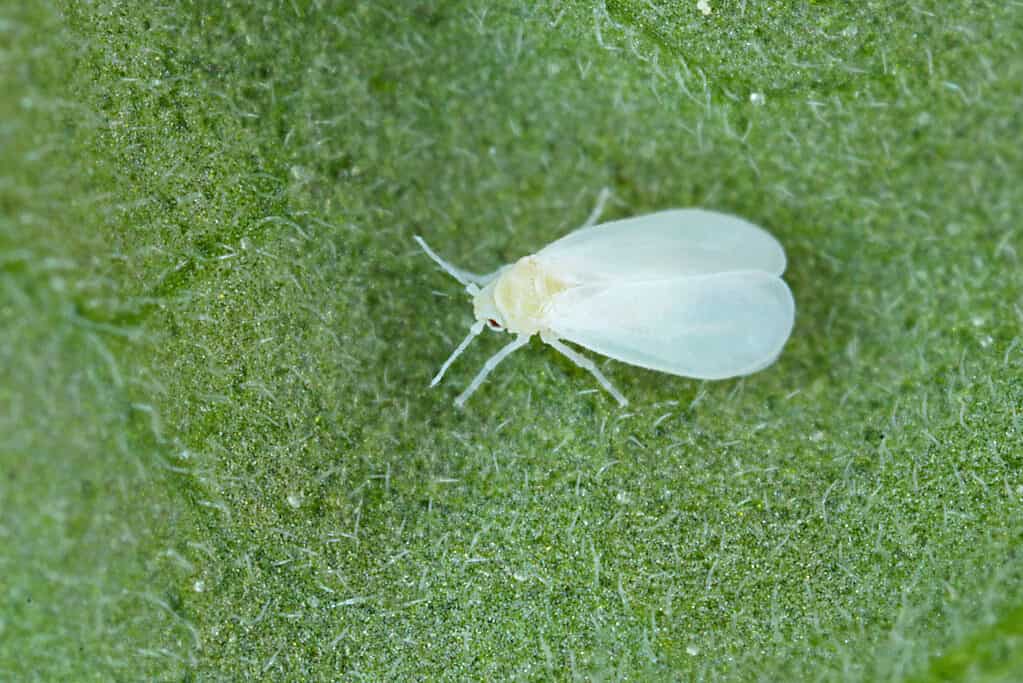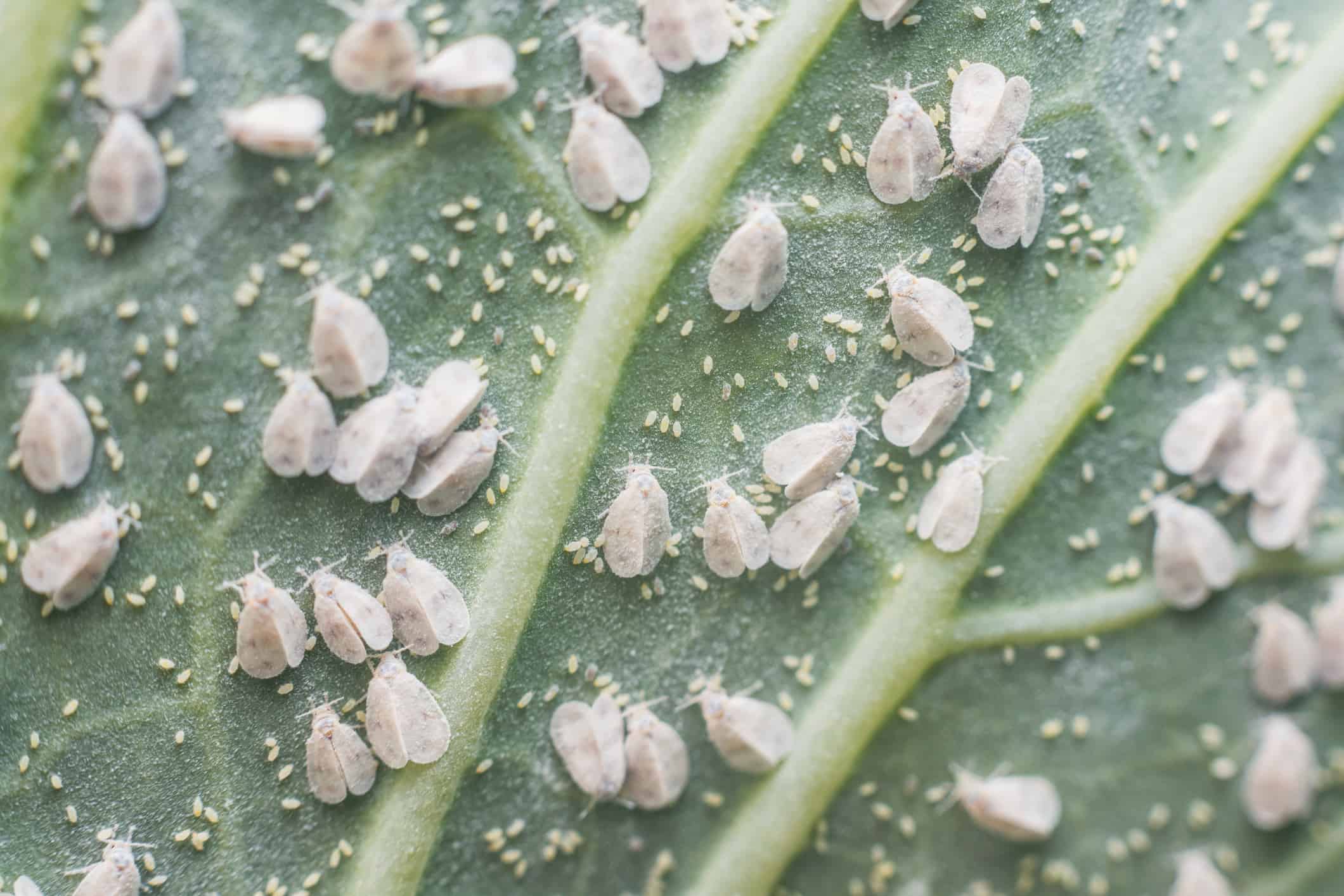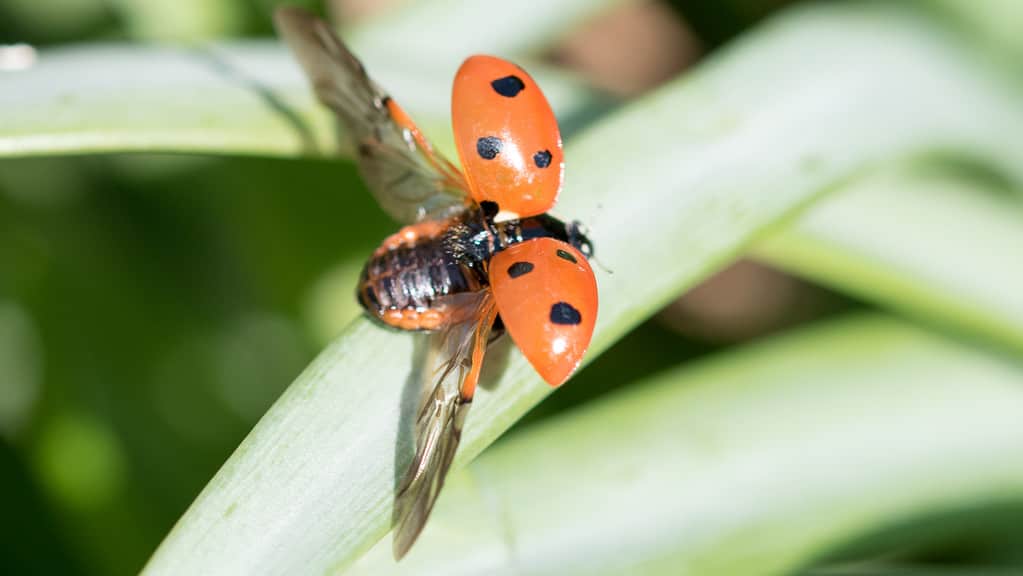If you’ve noticed small fly-like grayish-white insects on your plants hanging around on the underside of the leaves, you may have a whitefly infestation. Whiteflies can cause plants to wither and turn yellow. The tiny insects also transmit viruses from plant to plant. For the health of your plants, it’s better to catch the problem early and rid yourself of the pests before a full-blown infestation takes over.
There are many ways of dealing with an infestation of these pesky insects. Read on for nine ways to get rid of whiteflies. But first, let’s look at exactly what whiteflies are and how to spot them.
What Are Whiteflies?

Whiteflies are winged, soft-bodied insects about 1/16 of an inch long.
©Tomasz Klejdysz/Shutterstock.com
Although they’re called flies, whiteflies are not species of fly but are closely related to aphids. Looking more like a moth than a fly, whiteflies are tiny (only about 1/16th of an inch in length) and have an elongated triangular shape. They are winged and gray-white. Because they are so small, they may be difficult to spot on your plants.
What Kinds of Plants Do Whiteflies Infest?
Whiteflies can’t survive winter outdoors except in warmer climates. In USDA Hardiness Zone 7 or colder, the insects won’t live through the winter. In these areas, they tend to only be found on houseplants or in greenhouses. However, they can infest garden plants for a season if the plants are brought outside from an infested greenhouse. And in areas south of Zone 7, the pests can be found in outdoor gardens year-round.
The types of plants whiteflies are commonly found on include ornamental and vegetable plants such as cucumber, tomato, squash, poinsettia, and hibiscus.
How to Identify an Infestation of Whiteflies

Female whiteflies can lay 400 eggs on the undersides of leaves that hatch within six to 10 days
©iStock.com/Andrei310
If you’ve noticed your plants are withering and turning yellow, you may be dealing with whiteflies. Whiteflies suck the sap from the plant, causing them to wilt and die. They also leave a sticky substance called honeydew.
Check under leaves for small brown or yellow eggs or newly hatched nymphs. The nymphs will look like tiny white ovals. Female whiteflies can lay 400 eggs that hatch within six to 10 days. As you can see, their population can grow quickly and before you know it, you’ll be dealing with an infestation.
9 Ways to Get Rid of Whiteflies
There are many ways to rid your plants of whiteflies. You can manually remove them if you don’t have too severe an infestation. However, if you’re dealing with large numbers of pests, you may need to resort to using insecticide.
Here are 9 ways to get rid of whiteflies in your garden or houseplants.
1: Spray the Leaves With Water
Gently spray the undersides of the leaves with water. This will knock off the whitefly eggs and nymphs. Once off the plant, the nymphs won’t move but will starve and die when removed from their source of food.
2: Pick the Whiteflies Off the Plants
You can pick the pests off of the leaves or prune the infected leaves from the plant. Pruning the leaves will prevent the whiteflies from traveling up the entire plant.
3: Vacuum up the Bugs
If you’d rather not hand-pick the whiteflies off your plants, you can try using a small, handheld vacuum instead to remove them. Just be careful not to damage the plant’s leaves.
4: Use Neem Oil

Neem oil spray can be an effective deterrent for garden pests.
©Wild As Light/Shutterstock.com
Neem oil sprayed on the infected areas of the plant will kill the whiteflies without harming beneficial insects. However, be careful to avoid spraying neem oil directly on beneficial insects, like pollinators. It can kill them if they get a direct spray. Another benefit of neem oil is the strong smell will deter whiteflies from returning.
5: Use Insecticidal Soap
Spray a mixture of insecticidal soap on the leaves covered with whiteflies. Follow the directions on the package and spray on plants in the morning or evening when temperatures are cooler.
6: Use Reflective Mulch
Surround your plants with aluminum or silver polyethylene mulch. The mulch reflects light on the undersides of the plants and confuses the insects’ ability to locate the plant. Reflective mulch repels not only whiteflies, but flying aphids, spider mites, thrips, and mealybugs as well.
7: Encourage Natural Predators of Whiteflies

Ladybugs in your garden will munch on whiteflies.
©Konrad_Brambach/Shutterstock.com
Frogs like to eat whiteflies. To encourage frogs to eat the pests, moisten the leaves of your plants in the morning. The frogs will stick around to enjoy the cooler plant canopy and eat the insects. Other beneficial insects that prey on whiteflies include ladybugs, spiders, and dragonflies.
8: Control Your Garden’s Ant Population
Whiteflies leave a honeydew residue, similar to aphids. Ants are attracted to this residue and will farm the whitefly and chase away predators. A few natural ways to control ants in the garden include sprinkling cinnamon or cayenne pepper in your garden or spraying vinegar on the ground.
9: Inspect Plants Before You Buy

Check the undersides of leaves when buying plants for whiteflies.
©Siam SK/Shutterstock.com
When buying plants from greenhouses, always inspect the undersides of leaves for signs of whiteflies. You can avoid a whitefly infestation from invading your houseplants or outdoor garden by preventing them in the first place.
Thank you for reading! Have some feedback for us? Contact the AZ Animals editorial team.








